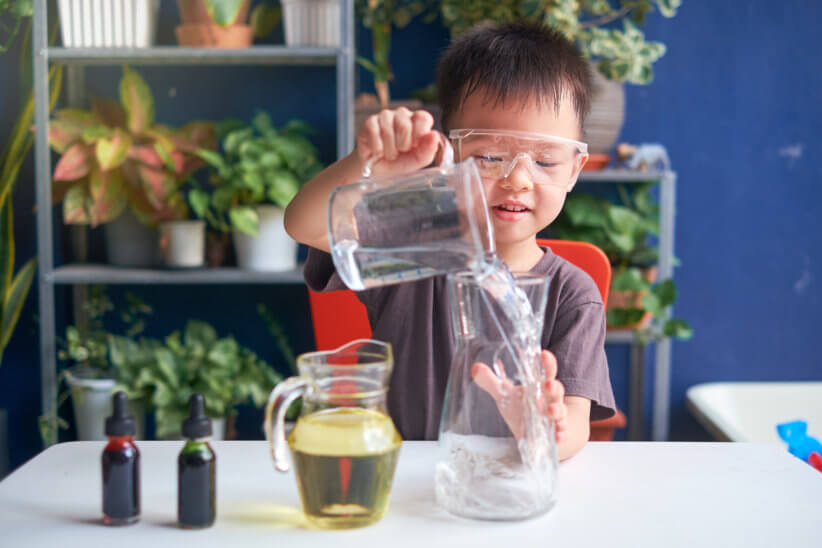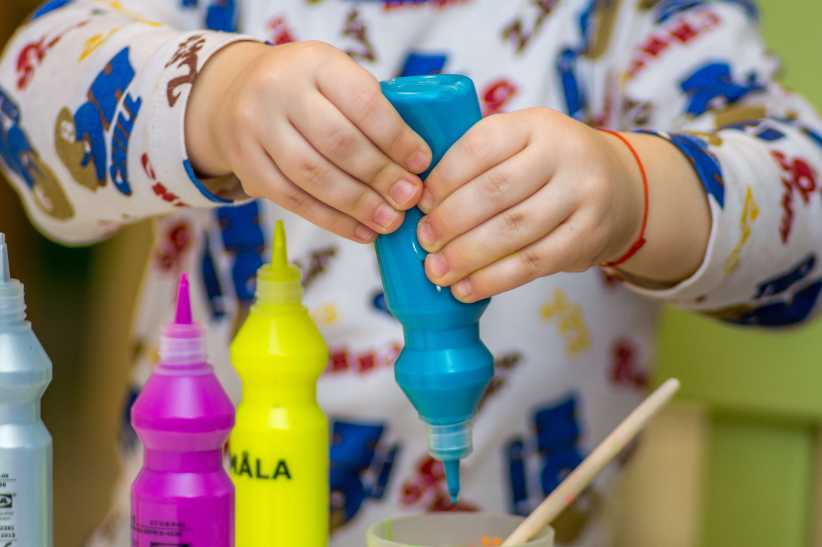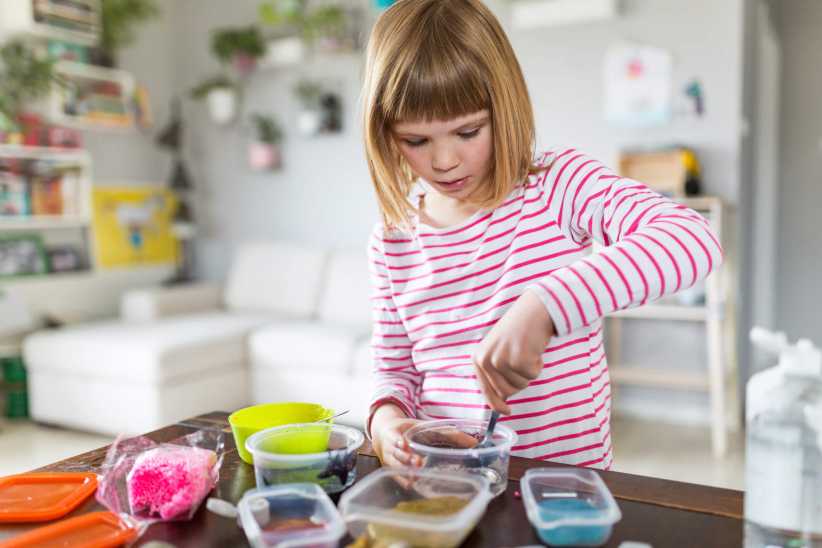
Science Projects to Do at Home
Science projects can be a load of fun. Kids come home from school and have to tell you about the bean plant they are growing or the awesome explosion that comes when baking soda and vinegar mix. As parents you can make them just as excited about science at home! This list is composed of experiments for all ages and interests. If your child is a visual learner, or a tactile learner, or simply loves looking at the stars then there are projects for each of them!
Would you like to see more fun indoor activities? Check out The Best Art Classes Offered for Kids in NYC!
Baking Soda Balloons
Supplies: empty water bottle, white distilled vinegar, baking soda, funnel, balloon
This science project is simple, but has fun and colorful results! When the baking soda mixes with the vinegar a chemical reaction takes place. As a result, carbon dioxide is created which fills and expands the balloon. The experiment can be performed by almost any age group, but assistance will be needed for little ones.
Grow your Own Crystal
Supplies: cup of water, 3 cups of sugar, wooden skewers (sticks or string), glass jar, saucepan, clothespins, food coloring is optional
This well known project is sure to make your day a little sweeter. When the sugar and water are combined there is too much sugar in the mixture. As the water in the jar evaporates and cools, the extra sugar remains and attaches to the sugar on the stick. The sugar hardens and returns to its original state! Parental assistance is needed, because this project requires the use of a stove and the handling of hot materials.
Invisible Ink
Supplies: lemon juice, small cup, cotton swab or paintbrush, paper, blow dryer
This is a super simple, fun project where your little ones will feel like spies. This project can be done by almost all age groups. However, assistance is needed to uncover the message. When heat is applied to the carbon compounds in the juice it makes some of the carbon leave and meet the oxygen in the air. Oxidation takes place turning the formally colorless lemon juice brown.
Egg Drop Challenge
Supplies: raw egg, masking tape, scissors, materials to build a carrier
This experiment allows your kids to explore gravity and force at a more advanced level. This may be best for tweens who like a challenge or it could be a fun group project for the whole family! The challenge is to build a container out of recyclable materials to protect an egg. Your kids must use engineering, decision-making, and tactile skills to be successful. However, if the egg breaks then they can always make another container!
Painting with Rubbing Alcohol and Salt
Supplies: piece of paper (preferably thicker paper or card stock), paintbrush, rubbing alcohol, salt, water, paper towels
This project is for the art lovers, because it combines science and beauty. When you dip the end of the paintbrush in the alcohol and drop it on the watercolor a circle forms because there is a reaction when the water and alcohol mix. The salt absorbs the water and some of the color leaving less saturated areas. Elementary school kids past fourth grade may understand the fundamentals of this project better.
Penny Raft Challenge
Supplies: square piece of aluminum foil, plastic straws, scissors, masking tape, up to 100 pennies, large bowl of water
This science project highlights engineering skills. It is not as difficult as the egg drop challenge, but it should still be performed by kids past third grade. The point of this challenge is to try different designs and see what shapes work best for a structurally sound raft or other projects such as a bridge. Constructing the raft is a tactile experience for children who like to use their hands.
Testing Gravity with Magnets
Supplies: 3 strong magnets, a metal ruler (regular ruler and tape), 3 metal paper clips, string, tape, something that is stackable, stick
In this experiment, younger children can explore and learn about gravity. It is a fun activity just for you and your little one. Setting up the project involves a few steps, but nothing is overly complicated. When you use the magnets the paper clips are so light that the magnetic force is stronger than the pull of gravity on the paper clips. This allows the paper clips to look like they are floating in midair!
Make your own Lava Lamp
Supplies: clean plastic bottle with cap (preferably with smooth sides), water, vegetable oil, Alka Seltzer tablet, food coloring
This is another classic project that is always fun to repeat. Older kids can complete this project on their own, but it may be exciting to do in a group. The reason the experiment is so cool is due to the floating oil which is less dense than water. The food coloring mixes with water. The Alka Seltzer tablet makes gas that floats to the top with some of the colored water creating a lava lamp effect in the oil.
Walking Water
Supplies: 7 glasses (preferably the same size), food coloring, 6 paper towels, water
This science project demonstrates capillary action. It is a super easy project that can be completed by all ages. It is also a great lesson! In nature, plants use capillary action to spread water from their roots to their stems and leaves. The water creeps between the gaps in the stems, or paper towels in this case, to its next location. By using color you can see the water traveling and the transfer of liquid to a dry area.
Make a Mini Constellation
Supplies: toilet paper roll (paper cup), white paper, push pin, scissors, pencil, flashlight, tape or glue, a constellation template is optional
This project is for the children who love the night sky. Patterns in the stars were spotted and named long ago and were used to help navigate and identify seasons. By making constellations your children are continuing a very old tradition as well as practicing to become astronomers. This is a crafty project for kids who like hands-on work. If you or your children are interested in learning more about constellations look up the mythology of each one!
Make your Own Cloud
Supplies: empty 16 oz plastic water bottle with cap, Isopropyl rubbing alcohol, safety goggles
If you are looking for a simple and quick activity, this is it! It can be performed by most age groups, though children younger than six may need some assistance. In this experiment, your child will witness a change in states (liquid to gas), which include vocabulary words such as water vapor, condensation, and pressure. To learn more about condensation and water vapor don’t forget to look up the water cycle!
Turn Milk into Plastic
Supplies: 1 cup of milk, 4 teaspoons of white vinegar, spoons, heat-resistant cup that can hold the milk, paper towels, stovetop and pan
This experiment is for kids who love science, especially chemistry. Similar to the baking soda balloon, mixing an acid (vinegar) and a base (milk) results in a chemical reaction. The change in pH leaves curdled milk to form plastic. Milk contains casein protein, so the plastic your child makes is a moldable plastic called casein plastic! Parental assistance is needed, at least to start, since hot milk and a stove are involved.











